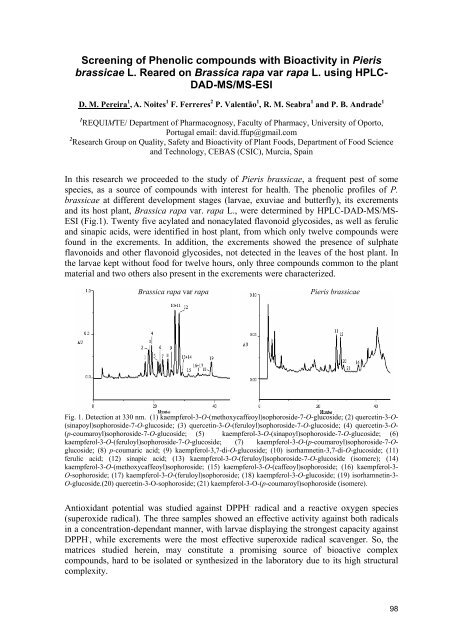IJUP08 - Universidade do Porto
IJUP08 - Universidade do Porto
IJUP08 - Universidade do Porto
- TAGS
- universidade
- porto
- ijup.up.pt
You also want an ePaper? Increase the reach of your titles
YUMPU automatically turns print PDFs into web optimized ePapers that Google loves.
Screening of Phenolic compounds with Bioactivity in Pieris<br />
brassicae L. Reared on Brassica rapa var rapa L. using HPLC-<br />
DAD-MS/MS-ESI<br />
D. M. Pereira 1 , A. Noites 1 F. Ferreres 2 P. Valentão 1 , R. M. Seabra 1 and P. B. Andrade 1<br />
1 REQUIMTE/ Department of Pharmacognosy, Faculty of Pharmacy, University of Oporto,<br />
Portugal email: david.ffup@gmail.com<br />
2 Research Group on Quality, Safety and Bioactivity of Plant Foods, Department of Food Science<br />
and Technology, CEBAS (CSIC), Murcia, Spain<br />
In this research we proceeded to the study of Pieris brassicae, a frequent pest of some<br />
species, as a source of compounds with interest for health. The phenolic profiles of P.<br />
brassicae at different development stages (larvae, exuviae and butterfly), its excrements<br />
and its host plant, Brassica rapa var. rapa L., were determined by HPLC-DAD-MS/MS-<br />
ESI (Fig.1). Twenty five acylated and nonacylated flavonoid glycosides, as well as ferulic<br />
and sinapic acids, were identified in host plant, from which only twelve compounds were<br />
found in the excrements. In addition, the excrements showed the presence of sulphate<br />
flavonoids and other flavonoid glycosides, not detected in the leaves of the host plant. In<br />
the larvae kept without food for twelve hours, only three compounds common to the plant<br />
material and two others also present in the excrements were characterized.<br />
Brassica rapa var rapa<br />
Pieris brassicae<br />
Fig. 1. Detection at 330 nm. (1) kaempferol-3-O-(methoxycaffeoyl)sophoroside-7-O-glucoside; (2) quercetin-3-O-<br />
(sinapoyl)sophoroside-7-O-glucoside; (3) quercetin-3-O-(feruloyl)sophoroside-7-O-glucoside; (4) quercetin-3-O-<br />
(p-coumaroyl)sophoroside-7-O-glucoside; (5) kaempferol-3-O-(sinapoyl)sophoroside-7-O-glucoside; (6)<br />
kaempferol-3-O-(feruloyl)sophoroside-7-O-glucoside; (7) kaempferol-3-O-(p-coumaroyl)sophoroside-7-Oglucoside;<br />
(8) p-coumaric acid; (9) kaempferol-3,7-di-O-glucoside; (10) isorhamnetin-3,7-di-O-glucoside; (11)<br />
ferulic acid; (12) sinapic acid; (13) kaempferol-3-O-(feruloyl)sophoroside-7-O-glucoside (isomere); (14)<br />
kaempferol-3-O-(methoxycaffeoyl)sophoroside; (15) kaempferol-3-O-(caffeoyl)sophoroside; (16) kaempferol-3-<br />
O-sophoroside; (17) kaempferol-3-O-(feruloyl)sophoroside; (18) kaempferol-3-O-glucoside; (19) isorhamnetin-3-<br />
O-glucoside.(20) quercetin-3-O-sophoroside; (21) kaempferol-3-O-(p-coumaroyl)sophoroside (isomere).<br />
Antioxidant potential was studied against DPPH . radical and a reactive oxygen species<br />
(superoxide radical). The three samples showed an effective activity against both radicals<br />
in a concentration-dependant manner, with larvae displaying the strongest capacity against<br />
DPPH . , while excrements were the most effective superoxide radical scavenger. So, the<br />
matrices studied herein, may constitute a promising source of bioactive complex<br />
compounds, hard to be isolated or synthesized in the laboratory due to its high structural<br />
complexity.<br />
98










